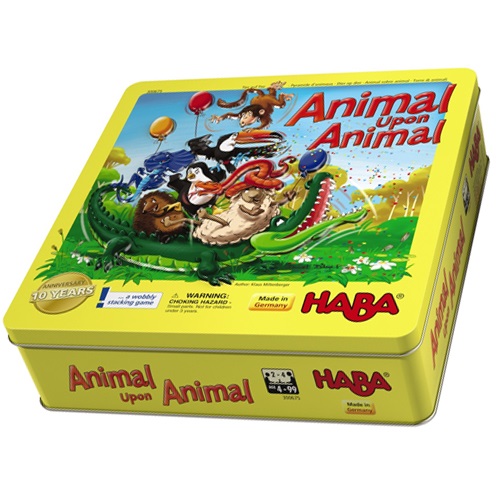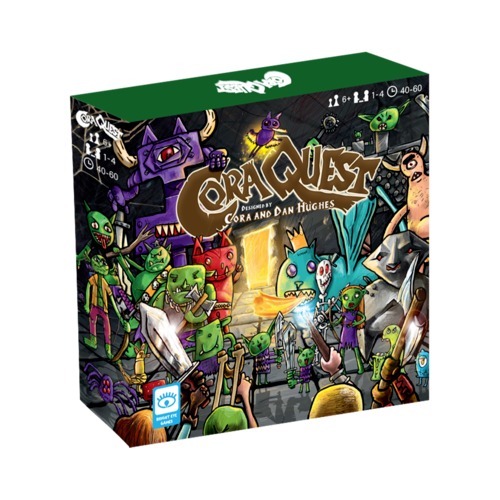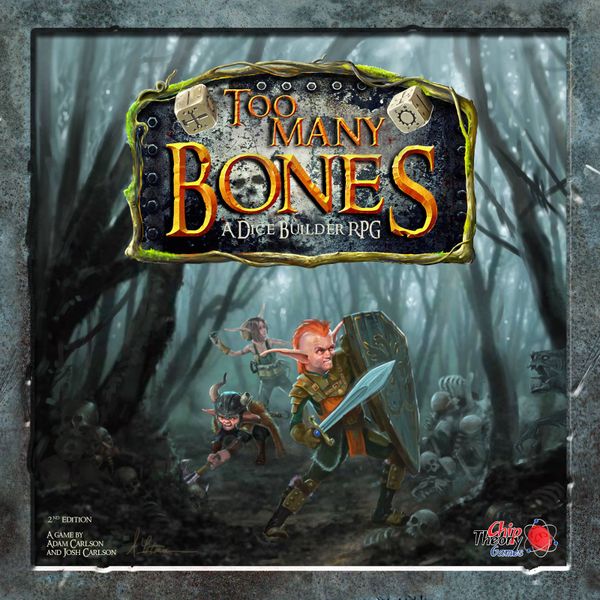You’ve set it up, your table awash in counters, cards, and conflict resolution tables. Your master strategy is ready to go from turn one. All that remains is how your opponent will act. You look across the table, meet their wide eyes, and notice Britain’s battleships are coated in cheese dust and your prized player aid is about to serve as a tissue for a chronically snotty nose. An ask is made: for a dice to roll, and a bowl of ice cream, for a couple preschoolers.
Axis Empires might be your dream, but to get your preschooler, ages three, four, and five, into board games, it’s best to meet them where they’re at: with animals, chunky dice, and chaos.
It’s a HABA World and the Kids Are Loving It
Take a run around the kid’s section of your favorite game store and you’ll see a friendly, red HABA logo all over. The German brand, nearly 100 years old, has a great line-up of games for young ages and preschoolers alike.
Why great?
Because they give the preschoolers a hook. Animal Upon Animal lures in a youngster with a friendly crocodile and its jungle menagerie, with the simple goal of stacking those critters on top of one another. Long before they understood the ‘rules’, my own kids had (and continue to have) great times dropping monkeys on penguins, or arranging all the meeples into fun groups and telling stories. That the figures are nigh indestructible and difficult to swallow, should you have a wandering infant around, make Animal Upon Animal an easy hit at our house.
First Orchard adds a little bit of structure with its chunky dice and equally heft fruit. The six-sided dice is easy to roll, and just tossing it around is a mini event in and of itself for a child learning their first game. The color rolled leads right to the action, dropping the fruit into your basket or advancing the fruit-munching crow towards the titular orchard. Just tracking how one thing leads to a consequence, and then giving the dice to the next preschooler (or parent) to roll, groups vital lessons into a pretty, sturdy package.
fruit-munching crow towards the titular orchard. Just tracking how one thing leads to a consequence, and then giving the dice to the next preschooler (or parent) to roll, groups vital lessons into a pretty, sturdy package.
Both of these are great intros for your toddler’s early game collection, and they’re inexpensive and resilient. When you’ve had your fill of fruit and stacked animals, HABA offers a funny foldable stacking card game Rhino Hero or the, perhaps subversive, Tidy Up, for when you want to attempt the impossible task of getting your youngest ones to clean up after themselves.
Look, nobody’s going to argue that your strategist brain’s going to get satisfied like it might with Brass: Birmingham or Paths of Glory, but you’ll find a particular spark when your preschoolers, your nephew or niece, or grandchild throws that dice for the first time.
And when they ask to play again?
Well, now you’re off on one of life’s most wonderful journeys.
Your Favorite Games Remade for Kids
Once you’ve whetted their appetite for taking turns and tossing dice with something like the HABA games, taking a light leap forward into the My First series, covering classic games like Carcassonne, Castle Panic, and Stone Age, continues the gentle introduction into core board gaming concepts. Targeted for ages four and up, these versions do exactly what you might expect, which is strip out more complex mechanisms (more on this later) to give you and your best buddy the essence of each game.
Sometimes, you might even find that essence is better than the full product . . .
Anyway, while us older folks might’ve started our board gaming adventures with ‘classics’ like Sorry! or Monopoly, the My First games don’t burn clock with old and random mechanisms like ‘roll to move’. You’re making real decisions here: My First Stone Age has you moving your worker, gathering resources to  build huts, and relying on memory to know which hidden tiles are best for what you’re trying to do. That’s a whole slew of core concepts (not to mention valuable life skills, like planning, memorization, and, you know, flipping tiles).
build huts, and relying on memory to know which hidden tiles are best for what you’re trying to do. That’s a whole slew of core concepts (not to mention valuable life skills, like planning, memorization, and, you know, flipping tiles).
If your gaming preferences veer more towards the dungeon crawling variety, kindergarten kiddos can venture forth into Coraquest, a pure monster-bashing delight illustrated, in part, by the designer’s own daughter (who’s also credited with the design itself). You’ll craft your hero, starting with a diverse cast, and go off on dice-tossing journeys. There’s no DM needed and minimal prep, perfect for an after school romp or a Saturday afternoon adventure.
From there, as reading skills improve, your options expand. I’d recommend Stuffed Fables as an enchanting next step, where your intrepid preschoolers make more narrative choices than just bopping critters on their noggins. Dice drive available options, but from there, it’s up to the players and their stuffed animal avatars. As if Toy Story mingled with the Redwall novels, complete with cute minis for enterprising parents to paint (or, you know, give your youngster the airbrush and see what happens).
more narrative choices than just bopping critters on their noggins. Dice drive available options, but from there, it’s up to the players and their stuffed animal avatars. As if Toy Story mingled with the Redwall novels, complete with cute minis for enterprising parents to paint (or, you know, give your youngster the airbrush and see what happens).
Or, you could take a look at your own collection and make some hard, amazing choices.
Make the Games Easier – For Preschoolers
There’s an argument to be made that any game, sufficiently simplified, is perfect for children. Bring out your copy of Memoir ‘44, leave the cards in the box,  and take turns moving the figures, rolling a dice or two here and there. First one to knock out all the toys wins. Or strip the energy and deck construction from Pokemon: The Trading Card Game and take turns having the creatures whack at one another, the challenge being to pick the best battler.
and take turns moving the figures, rolling a dice or two here and there. First one to knock out all the toys wins. Or strip the energy and deck construction from Pokemon: The Trading Card Game and take turns having the creatures whack at one another, the challenge being to pick the best battler.
The obvious advantage to stripping down your favorite games to make them more accessible is that you don’t need to stuff your shelves with new cardboard. The disadvantage is, well, that you have to do the slimming. Pick the wrong rules to remove or change the goal too much and your new Anachrony remix might not make any sense.
So, when browsing your collection for malleable marks, consider a few helpful guidelines:
- Co-op trumps competition.
- Cooperative games invite rules fudging anyway, and those Pandemic diseases aren’t going to protest when you let everyone fly wherever they want to go. Not having to pick a winner keeps any smoothed over score tracking out of the picture, not to mention handling any sore loser reactions from a toddler kept up past naptime.
- Murder the Words
- Unless your kiddos are older, any element of a game abounding with text is a good candidate to cut. Keywords and flavor text mean nothing if your little ones aren’t going to read it, so for games like Magic, just play with creatures and basic lands, then throw in simpler direct damage spells as they get used to it. Have Summoner Wars? Point out the number and dice in the card corners and ignore the rest.
- Keep it Quick
- Sure, you might want to spend your Saturday playing Empire of the Sun with your five year-old, but some things are best left to daydreams. Instead, shrink the battlefield. Play a single, simplified Too Many Bones encounter, or slaughter some goblins in Massive Darkness 2, then take a break to run around outside. Let your kiddo tell you if they want to play more, rather than expecting them to log long hours at the gaming table.
Get Your Preschoolers Gaming
Immersing your young ones in the hobby is a unique, amazing adventure for any gaming parent, and taking small steps is the easiest way to start. Board games for ages three, four, and up exist, are far better than the P
archeesi and War of yore, and can lead right into titles you already love. Taking those same games and stripping away extra rules, too, can give you a great, kid-friendly experience while keeping most of what you love. All it takes is a little bit of effort.
Soon enough, you’ll be sitting across from your favorite playing partners, ready to embark on a grand quest, score some crucial points, or solve a sneaky puzzle, all before bedtime. And that, my friends, is when you know you’ve made it.
